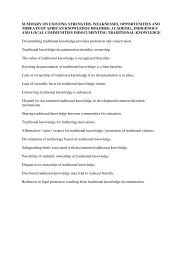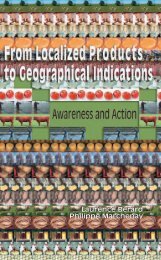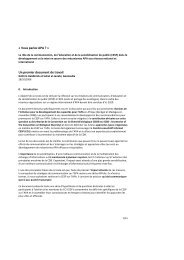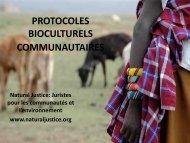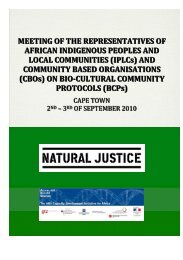The History of Farmers' Rights - Fridtjof Nansens Institutt
The History of Farmers' Rights - Fridtjof Nansens Institutt
The History of Farmers' Rights - Fridtjof Nansens Institutt
Create successful ePaper yourself
Turn your PDF publications into a flip-book with our unique Google optimized e-Paper software.
36 Regine Andersen<br />
tation at the national as well as international level. It covers all provisions<br />
pertaining to farmers’ rights in the Treaty. A thorough presentation <strong>of</strong><br />
Article 9 on farmers’ rights is provided on pages 67–78. <strong>The</strong> history <strong>of</strong><br />
the negotiations on farmers’ rights is sketched, and interrelations with<br />
other international agreements are highlighted, with special emphasis on<br />
the Union for the Protection <strong>of</strong> New Varieties <strong>of</strong> Plants (UPOV). On this<br />
basis, the authors proceed to explain the content <strong>of</strong> the various provisions<br />
<strong>of</strong> Article 9 and discuss possible ways in which Contracting Parties may<br />
implement them.<br />
***<br />
Salazaar, Rene; Bert Visser & Niels Louwaars (forthcoming 2006):<br />
‘Protecting Farmers’ New Varieties: New Approaches to <strong>Rights</strong> on<br />
Collective Innovations in Plant Genetic Resources’, World<br />
Development, accepted for publication.<br />
This forthcoming article documents how modern varieties developed in<br />
the formal sector have gradually replaced landraces as a source <strong>of</strong> diversity<br />
for many small-scale traditional farmers. However, this development<br />
has not done away with farmer-breeding, which is vital in traditional agriculture.<br />
This knowledge is <strong>of</strong> great importance when designing plant<br />
breeders and farmers’ rights, in order to ensure food security and genetic<br />
diversity. <strong>The</strong> major challenges are to warrant the recognition <strong>of</strong> the collective<br />
innovation and breeding efforts <strong>of</strong> farmers, to allow access to<br />
relevant genetic resources, and to keep these materials freely available for<br />
use and further breeding – while at the same time ensuring effective<br />
benefit sharing, the authors conclude.<br />
4.3 Major works and articles on farmers’ rights – regional and<br />
national levels<br />
In this section, we have collected major works and articles on farmers’<br />
rights in several regions and countries. We have sought to cover major<br />
contributions as well as particularly interesting inputs to the debate in<br />
these regions/countries.<br />
India<br />
<strong>The</strong> Indian Protection <strong>of</strong> Plant Varieties and Farmers’ <strong>Rights</strong> Act <strong>of</strong> 2001<br />
is a landmark in the realization <strong>of</strong> farmers’ rights, as the first act <strong>of</strong> legislation<br />
in the world to provide extensive rights to farmers. It is therefore<br />
particularly interesting to follow the discussion on this act and to follow<br />
its implementation. Various challenges arose along the way, and the following<br />
contributions cover a wide range <strong>of</strong> viewpoints. We start with a<br />
manual designed to assist practitioners in implementing the new act, and<br />
then <strong>of</strong>fer short introductions to the many contributions to the discussion<br />
<strong>of</strong> this legislation, in chronological order.<br />
Ravi, S. Bala (2004): Manual on Farmers’ <strong>Rights</strong> (Chennai: M.S.<br />
Swaminathan Research Foundation).






